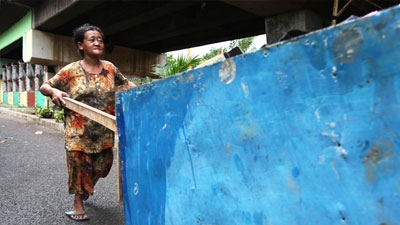Jakarta, March 1, 2012 - Every day Murti searches through Jakarta's garbage for things to recycle. When the weather is good, she can make up to Rp 20,000 ($2.2) each day, but only Rp 15,000 ($1.6) if it rains. She is proud to earn her living instead of begging but her income is not really enough to support herself and her son, a high school student. “While it is difficult to make ends meet, I want my son to continue his education so that he will have a better life in the future,” she insists. However, Murti and her son would probably not be classified poor by official Indonesian standards.
Official poverty in Indonesia has fallen from 23.4 percent in 1999 to 12.5 percent in 2011, but around 40 percent of Indonesians live beneath 1.5 times the poverty line, like Murti. This makes them vulnerable to shocks, and people move into and out of poverty easily. Half of the poor each year are newly poor, and one in four Indonesians has been poor at least once in the last three years. A safety net is needed to protect vulnerable households and help the poor work their way out of poverty.
As Indonesia matures into a middle income country, the government is trying to improve social assistance as part of its plan to reduce poverty to 8-10 percent by 2014. There are now a number of household social assistance programs in Indonesia, including subsidized rice, health fee waivers, cash transfers for poor students, a conditional cash transfer, and a temporary unconditional cash transfer. It aims for each program to be more effective, and for the programs to work together better. The World Bank has just completed two major reports which examine social assistance in Indonesia. The intent was to provide Indonesian policy makers with high-quality and independent research that could be used to help inform and guide key policy decisions.
Identifying the Needs, Making Recommendations
Protecting Poor and Vulnerable Households in Indonesia is the first major assessment of social assistance in Indonesia. While some programs have been effective, the report finds that overall social assistance does not go far enough in protecting the poor and vulnerable. Programs do not cover enough people. Benefits are not sufficient or do not arrive at the right time, and some risks are not covered at all. Too many poor people miss out on programs altogether, and awareness of programs is low.
Existing programs need to improve, and greater coordination between programs is needed if Indonesia is to enjoy a complete safety net. Murti pointed out that improvements are still needed. “My son won’t eat the rice because it has bugs and smells bad,” she commented about the rice for the poor program that she receives.


